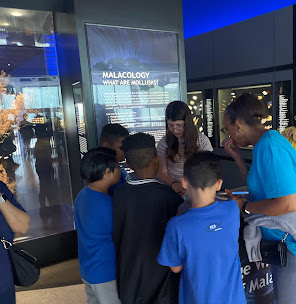Day 9: Independent Research
Today went very well. Unfortunately, I did not present... but I definitely plan to do so tomorrow, so I spent today getting ready for that.
The first thing I did was spend time practicing with the paleo cart, going through the usual processes of research and note-taking. Hopefully, I'll be able to move on to other paleo carts soon. In the meantime, I am satisfied with how the presentations are going for the malacology hall, so I'll definitely continue with those.
Then, about halfway today, I also went to get the malacology touch cart, to get more comfortable with more specimens so I could present them tomorrow. As I established yesterday, having pretty but durable specimens on display is an approach I prefer, especially with how lively the younger visitors can get. So I tried to apply this logic to those that I chose today.
While I had the malacology cart, I spent some time exploring what different specimens I could use while still keeping the pattern of "one class each". I did this by eliminating the ones which I thought were too fragile, and limiting it strictly to those which I would be confident having the visitors handle. When I had limited it to three specimens, I started looking up information for each, and noting it down to be prepared for tomorrow.
Here are the three specimens I chose:
 |
| Tiger cowrie |
This is a "tiger cowrie", and belongs to the gastropod class. It is known and known primarily for its beautiful patterns. The cowrie remains a common specimen in reefs across the Indo-Pacific, and is really important to marine ecosystems. This mollusk eats sponges and other mollusks with its long taste buds.
 |
| Squid pen |
These next ones are from the cephalopod class, and are "squid pens." While most cephalopods do not have an external shell, except for the chambered nautilus, squids have internal shells which support its structure. So, the "pen" is the internalised shell which serves as a site of attachment for muscles, as well as to further protect organs. For this particular specimen, visitors are not supposed to touch them since they are extremely delicate.
 |
| Angel wing clam |
For the third specimen, this is the "angel wing clam," or "cyrtopleura costata", and is a bi-valve mollusk of the Pholadidae family. It can be found in the north east Atlantic Ocean and Central America. This mollusk has a pair of delicate asymmetrical white valves, and generally grows up to 7 inches in length. Again, this specimen comes with a container, and due to how delicate it is, I would prefer to not give it to the visitors...
By the time I finished with the malacology cart, it was already time to leave. So, even though I did not present today, I'm confident about doing it for tomorrow. I'm going to ask Ms. Leap to help with some pictures, since when I asked her today she said it should be fine if it's only showing my front... but we'll see...
I look forward to tomorrow. With presentations planned for the day, and the fact that it will be the end of M-Term, I can't wait to make the most of it!


Comments
Post a Comment